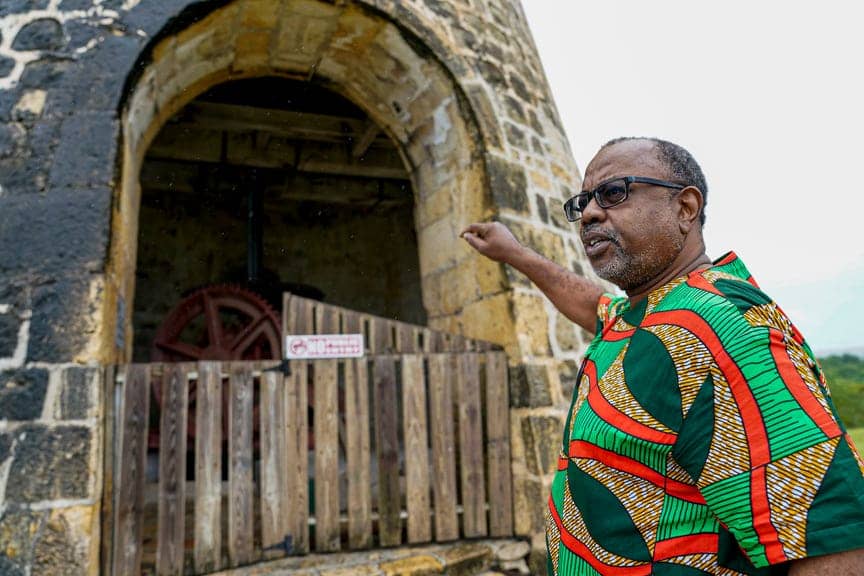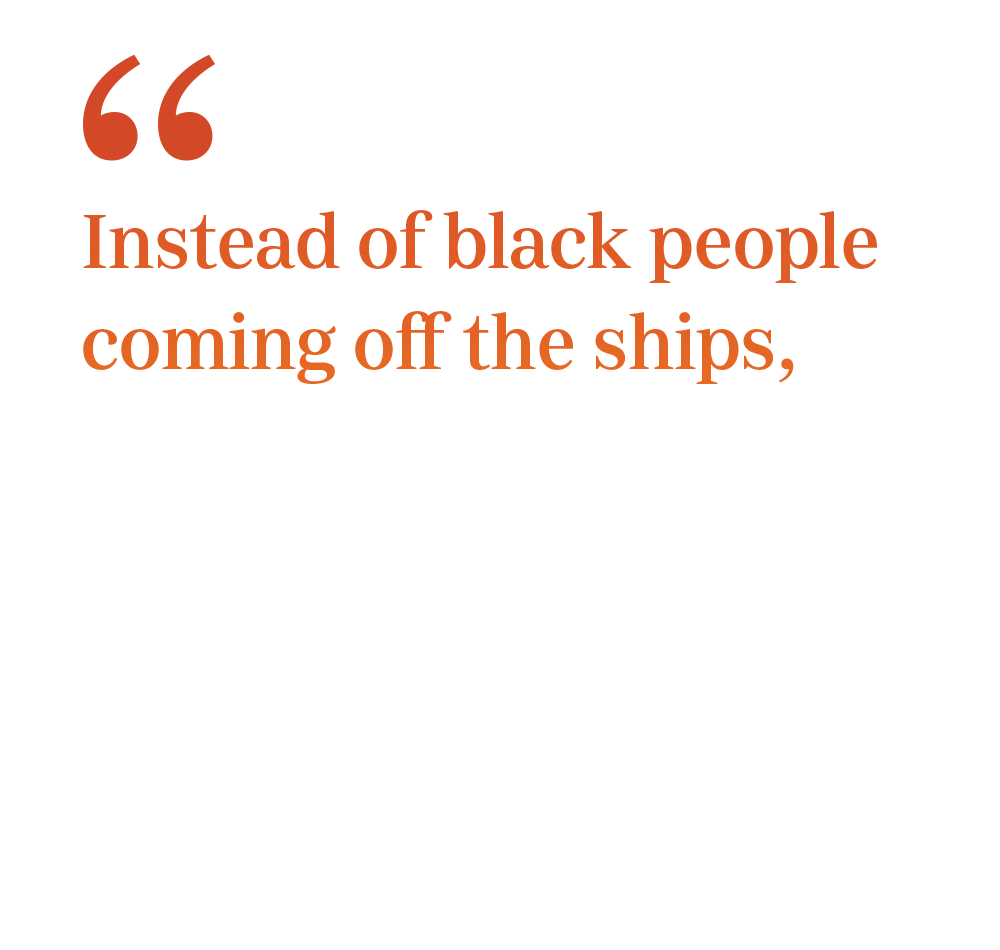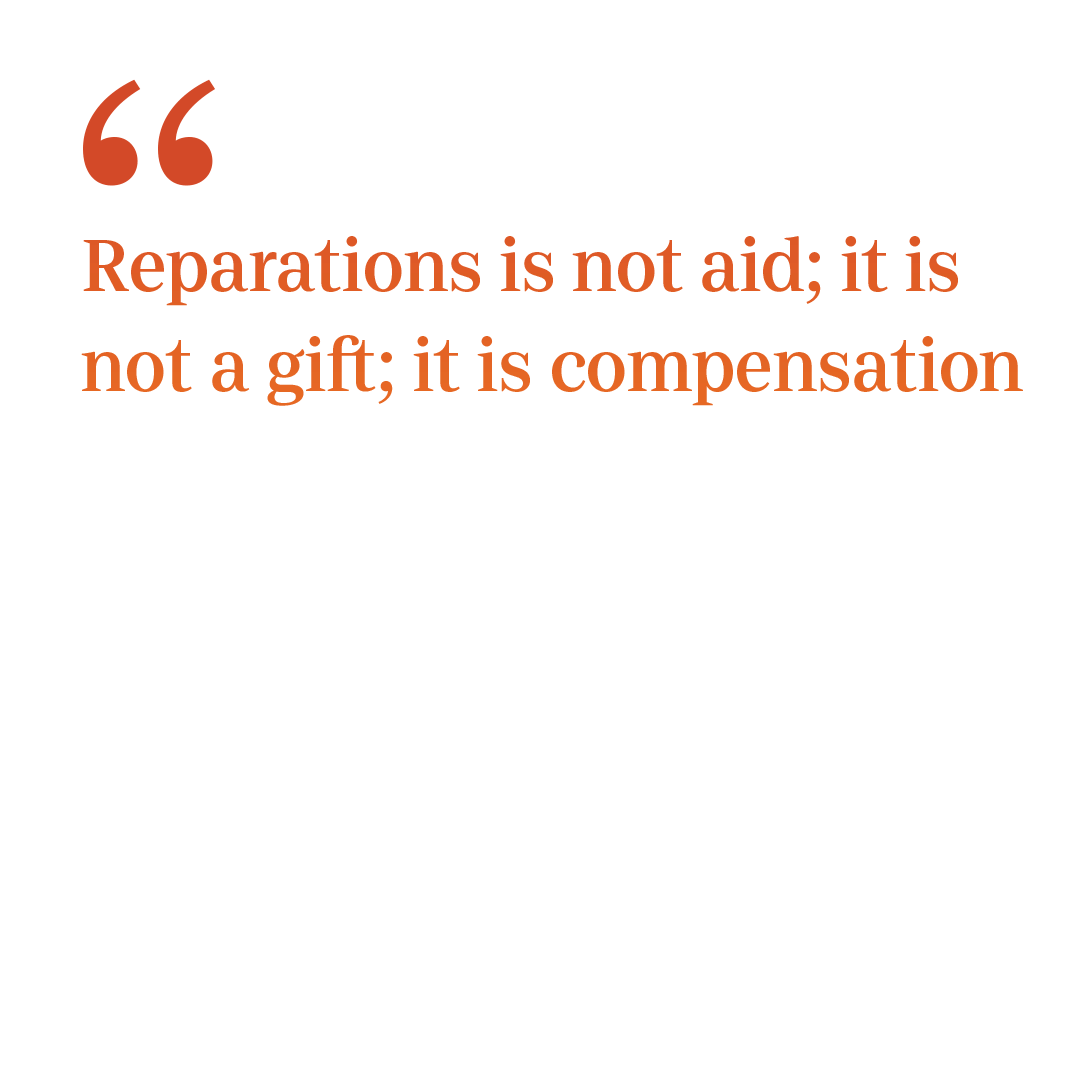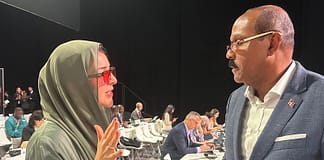
USA TODAY
Dorbrene O’Marde paced back and forth, trying to quash evil spirits. He had been to many former sugar plantations on this small island, but last month was the first time he’d seen the dungeon.
O’Marde knows well Antigua’s long history of slavery – Africans ripped from their homelands, forced to work on sugar plantations for British owners. But the dungeon, with its dark inside smelling of sea salt and littered with dead crabs, stood as another visible reminder.
Enslaved Africans – his ancestors – would have had to climb through the small opening into this windowless cell.
It unsettled him.
“Vengeance is not something good to wear,” he said.
Instead, the 69-year-old is helping lead a group of Caribbean islands in demanding reparations from countries whose citizens profited off hundreds of years of unpaid labor.
“It’s my life’s work,’’ said O’Marde, who chairs the Antigua and Barbuda Reparations Support Commission and is a vice chair of the Caribbean Reparations Commission. “I watch my Caribbean countries struggling. I watch up and down this region, the inequities. I watch the failures. I watch my governments and my people struggling against the legacies of colonialism and enslavement.”

Renewed interest in reparations
Thousands of miles north, the United States is grappling with how, and if, it will be held accountable for its own troubling history of enslaving Africans.
Debates about reparations have been the focus of campus forums, columns, books and even a recent congressional hearing. Interest has also renewed with commemorations of the 400 years since the first Africans were brought to the British colonies.
Not since Reconstruction has reparations been so much at center stage.
Yet no country has paid money to descendants of Africans who were victims of the transatlantic slave trade, experts say.
Instead, universities have taken the lead on what they call reparative justice. Georgetown University apologized to descendants of slaves who were sold to pay school debts and recently pledged to raise $400,000 a year for programs to help those descendants. In October, Princeton Theological Seminary in New Jersey announced a nearly $28 million plan, including scholarships to descendants of enslaved Africans.
But the model for these programs is Brown University, which issued a groundbreaking report in 2006 about its founders’ connection to slavery and created a center to research slavery and injustice.
“We have an obligation to tell the truth about our history because we’re a university,” said Ruth Simmons, the former president of Brown.
Other universities, she said, can do the same. “We’re best at doing the research and speaking the truth of what transpired … I think the truth is always worth it.’’
Just this week officials from the University of Glasgow were in Antiqua, Jamaica and other islands working with the Caribbean Reparations Committee to help solidify an unprecedented partnership with the University of the West Indies to help islanders “erode the legacies of slavery and racism.”
“It’s high time we address this,’’ said David Duncan, chief operating officer and University Secretary at the University of Glasgow.
An unfulfilled promise
When slavery was abolished in 1865, the federal government promised millions of freed men and women “40 acres and a mule.”
That promise went unfulfilled.
The late Rep. John Conyers, a Democrat from Michigan, had introduced a reparations bill every session since 1989. It never passed.
This spring, Rep. Sheila Jackson Lee, a Democrat from Texas, and New Jersey Sen. Cory Booker, a 2020 Democratic presidential candidate, re-introduced legislation to create a commission to study reparations.
“The initial wealth of this nation was built on the backs of enslaved Africans who worked … for absolute free and suffered brutality,’’ explained Jackson Lee.
A hearing in June on H.R. 40, named after “40 acres and a mule,’’ was packed. There’s talk of another hearing. Democratic leaders and other presidential candidates support it.
But Senate Majority Leader Mitch McConnell doesn’t think reparations “is a good idea” and could block the bill in the Senate.
“We’ve tried to deal with our original sin and slavery, by fighting a civil war, by passing landmark civil rights legislation. We’ve elected an African American president,’’ he said last summer. “We’re always a work in progress in this country, but no one currently alive was responsible for that.’’
He’s not alone in that feeling. Opponents say determining who would be eligible for payments would be difficult and costly. It could also “inflame our already frayed political discourse,” said Steven Greenhut, western region director for the conservative R Street Institute.
But William Darity, a professor at Duke University, argues the federal government, which “maintained the legal framework for apartheid in America’’ should pay black descendants of American slavery and eliminate the racial wealth gap.
Some countries have apologized for their part in slavery while others have created commissions to study what role they played.
“If you want to say sorry for something, you must know what you have done,’’ said Domenica Ghidei Biidu, a member of the Council of Europe’s European Commission against Racism and Intolerance.
Acknowledging that wrong, she said, may make descendants feel like “a healing process can start.’’

Slavery and Brown University
Maiyah Gamble-Rivers trudged through the snow one recent afternoon to get to a highlight on the Slavery & Legacy walking tour at Brown University.
The memorial – a half sphere and a broken chain rising to the sky – is only steps from the oldest building on campus. Free and enslaved blacks helped build University Hall.
Inside is an exhibit entitled “Hidden in Plain Sight: American Slavery and the University,’’ which tells the story of the school founders’ role in trafficking Africans.
The tour also includes a stop by a quad named after Simmons, the university’s first black president. There’s another stop in front of Page-Robinson hall, named for Inman Edward Page and Ethel Tremaine Robinson, the first black man and woman to graduate from Brown.
Gamble-Rivers created the tour. A native of Providence, she hadn’t imagined working at the university. She never even visited as a high school student. But now the 30-year-old program manager at the Center for the Study of Slavery & Justice said she’s proud to share the history of blacks on campus and in Rhode Island – even the horrors.
“It is not a choice,’’ she said. “It is a responsibility and it is a duty.”
Brown was one of the first universities to exhaustively examine its connection to slavery. The tour, the center, the memorial and even Gamble-Rivers’ job came about because of the 2006 report about the history of slavery there.
Simmons, then president of Brown and the first African American to head an Ivy League school, said some warned her it was dangerous to examine the school’s past. She did it anyway.
“It seemed like the right thing to do.’’
She said the country has a “long history of forgetting.”
The 116-page report told of the many slave voyages funded by the university’s founders.
Rhode Island sent about 1,000 ships to the West Coast of Africa to capture Africans and sell them, mostly in the Caribbean. Textile merchants did a brisk business selling “Negro cloth,’’ a course fabric, to plantation owners in the South. Others made fortunes building parts for slave ships.
Universities, particularly ones in the North, were major benefactors of the trafficking trade in the South and the Caribbean, according to Craig Steven Wilder, author of “Ebony & Ivory: Race, Slavery, and the Troubled History of America’s Universities.”
At Brown, its founder’s own records tell that story.
On campus one recent afternoon, librarian Kimberly Nusco gingerly turned the brittle pages of a 1764 accounting book for the Sally, a voyage funded by Brown’s founders.

Kimberly Nusco, a librarian at the John Carter Brown Library at Brown University, showed the 1764 accounting book for the Sally, a slave ship that…
The book, warped with age and encased in an acid-free blue box, is housed in the John Carter Brown Library. It was on display in a room kept cool to protect it and other rare books collected from around the world.
The spine of the Sally is ripped and the back cover missing, but details of the journey list the day and number of Africans captured off the West Coast.
Thirty seven were taken on June 10, 1764.
That day, the crew traded 55 gallons of rum and one gun “for a girl slave.”
The ledger shows captives attempted to revolt, but failed. The crew killed some. Others died from injuries. By the end of the long voyage, 109 of the 196 Africans had died.
More than a year after the ship left Providence, it arrived in Antigua, where most of the surviving Africans were sold.
The library’s book collection and business papers provide other proof of how the Brown family profited from captured Africans. “You can’t argue it away,’’ said Nusco.
Busts of the Brown men sit atop a fireplace and bookshelves in the center of the ornate library and similar homages are displayed throughout campus.
“Every day I’m facing the portrait of the first president who was a slaveholder,’’ recalled Simmons, who retired as Brown’s president in 2012. “It is everywhere around and yet invisible to us.’’
In the years since the report, the university created the Center for the Study of Slavery & Justice. It houses a rotating exhibit of work by black artists. It’s also where the slavery tour starts, and where staffers hold classes and run programs, including one that takes Providence high school students on a civil rights tour through the South.
Earlier this month, the center hosted a conference on 1619 featuring scholars, student activists and archaeologists.
As the Brown steering committee worked on its report, it made sure the process was transparent, Simmons said. There were community forums. The final report is posted online and in print.
Simmons pushed back, however, when there was talk of her – as the university president – apologizing for slavery.
“I said, ‘That’s ridiculous,’’’ she recalled. “I can’t issue an apology for slavery because of who I am … If the board wants to do it, they are free to do it, but it makes no sense for me to do it.
“It would be too convenient to have an African American apologizing for slavery.”
To this day, Simmons, who now heads Prairie View A&M University, a historically black college in Texas, said she often gets calls from universities and local governments asking for help.
“We provided a model that didn’t scare people,’’ she said, one that allowed others to follow “because they could point to Brown and say, ‘But Brown did it, and they didn’t crumble.’”

Slavery and the University of Glasgow
Officials at the University of Glasgow looked to Brown and others as they examined their own history.
While many on the Glasgow campus opposed slavery, the university acknowledged in its 2018 report that it, too, had benefited from donors who made their fortunes from captured Africans.
In the wake of the report, the university pledged to raise the equivalent of $22 million over 20 years to partner with the University of the West Indies. Together, they plan to create a research center and examine health issues and other concerns in the region. They will also fund scholarships and exchange programs.
Antigua, which is 108 square miles long, is known for its majestic beaches. Here is a view from the Hawksbill, one of the oldest resorts…
“What we’re trying to do is to use our academic expertise and to devote some of our research power to try to improve the well being of people in that part of the world,’’ said Duncan, the university’s chief operating officer.
Caribbean officials seemed to welcome the effort, Duncan said. “Whether that’s justice, I think others have to judge that.”
O’Marde said many plantation owners in Antigua and other Caribbean islands funded universities, some considered among the best in the world. He simply wants them to pay their part. This new partnership, he said, can help “define the battle’’ for reparations.
“All of a sudden it moves from theory … to reality,” he said.

From slave ships to cruise ships
Sékou Luke wound his way around the harbor in St. John’s, the capital of Antigua, showing where ships carrying captured Africans docked hundreds of years ago. Many came from Ghana, Benin and Nigeria.
The harbor provided easy access to unload human cargo.
Luke pointed across the clear waters to where ships were sometimes steered so the smell wouldn’t offend whites. The stench of death, human waste and misery trailed ships after months at sea.
Sékou Luke, who helps with the Antigua and Barbuda Reparations Support Commission, shows visitors a barracoon, a cottage that was used to hold enslaved…
Today, luxury cruise ships pull in.
“Instead of black people coming off the ships, now it’s white people,’’ said Luke, who works with the Antigua and Barbuda Reparations Support Commission.
Fancy shops sell Michael Kors purses, diamond jewelry and sunglasses. Those shops are steps from where Africans were paraded through the streets so they could be auctioned.
A cottage once used to wash Africans before they were sold recently housed an art studio.
There are few signs marking the history of slavery. No reminders of the brutality, the inhumanity.
“You can’t tell anything happened,’’ said Luke. “It’s pretty, but haunted.”

Antigua’s case for reparations
The island was once blanketed with sugar plantations where tens of thousands of Africans were forced into punishing work, planting sugar cane, harvesting the crops and then laboring in mills to process the cane.
The mortality rate was so high plantation owners factored in the cost of bringing in new free labor from Africa every year.
Business boomed with increased demand for sugar and rum. Antigua became a leading producer until the industry faded in the 1950s.
Antigua, an island in the eastern Caribbean, once relied heavily on its production of sugar. Plantation owners used the free labor of enslaved Africans to…
The transatlantic slave trade was abolished in 1807. But on Antigua it wasn’t banned until 1834, when 30,000 people were emancipated. The island remained mostly under British rule until 1981.
Advocates for reparations argue slavery’s impacts are long lasting. Many of the small islands are economically isolated from trade, access to capital and education resources. The region faces a health crisis, including high rates of diabetes and hypertension. The poverty rate hovers around 30 to 35 percent and basic items are costly because many must be imported.
Verene Shepherd, director of the Centre for Reparations Research at the University of the West Indies, and other commission leaders want countries that committed the ‘‘crime’’ to make amends.
“We believe there is a case to be answered by those who enslaved our ancestors, brought them to this part of the world, established plantations, worked them to death, expropriated and appropriated, developed themselves – and left us underdeveloped,” said Shepherd, a commission vice chair.
Betty’s Hope, a former sugar plantation, was one of the largest on Antigua. Local historians said there were more than 200 plantations on the island….

Antigua reparations: ‘Why not us?’
Old plantation windmills – some in ruins, others intact – still dot landscapes.
A statue honoring Prince Klaas, who was accused of planning a slave uprising in 1736, towers over visitors in the capital. Klaas and dozens of others were tortured, then executed.
Signs bear names like Freetown, Freemans and Freemanville. Newly freed Africans named the communities.
Edith Oladele, founder of the African Slavery Memorial Society, and others hope to open a museum to preserve that history and more. “If we don’t keep our history together nobody is going to do it,’’ she said.
That history fuels O’Marde’s passion to fight for reparations.
The playwright and director, who was once involved in the Black Power Movement, said it’s hard not to notice that others who have suffered crimes against humanity have received reparations.
Proponents cite examples of Japanese Americans receiving payments for being sent to internment camps in the United States during WWII. They also note Florida’s payments to African-American victims of the 1923 massacre in Rosewood, Fla.
“The question becomes obvious,’’ O’Marde said. “Why not us, especially when our claim perhaps is the largest, the most documented, most proveable – if there’s such a word – claim of them all?”
O’Marde credits ‘‘bold political leadership’’ with demanding reparations.
Earlier this fall, Antigua and Barbuda Prime Minister Gaston Browne called out Harvard University for not responding to his request for reparations. Isaac Royall, Jr., a plantation owner in Antigua, helped fund Harvard’s first law professorship in 1815.
“Reparations is not aid; it is not a gift; it is compensation to correct the injustices of the past and restore equity,’’ Browne wrote to Harvard University President Lawrence Bacow.
Edith Oladele, founder of the African Slavery Memorial Society, plucked leaves off a bush she said is native to West African countries, including Cameroon and…
Antigua’s leaders and Bacow recently talked by phone and plan to discuss how Harvard and University of the West Indies might collaborate, said Jim Newton, a spokesman at Harvard.
The Caribbean Reparations commission, chaired by Hilary Beckles and formed in 2013, is made up of nine islands and countries, including Haiti, Jamaica, Antigua and Barbuda, St. Vincent and the Grenadines, St. Lucia, Barbados, Trinidad and Tobago, Guyana and Suriname.
Its 10-point plan calls for a formal apology, reparations, programs to address health issues and debt elimination, among other things.
The head of CARICOM’s subcommittee on reparations sent letters in 2016 to Britain, Portugal, France, Spain, the Netherlands, and others, asking to meet to discuss reparations for the region. The meetings didn’t happen.
But that hasn’t deterred leaders of the commission, who plan to send a second request to even more countries and with more details.
“Every movement needs time to grow,’’ said Shepherd. “Emancipation did not happen when some people wanted it to happen. It took hundreds of years.”

Taking a stand
High above Nelson’s Dockyards on the edge of a cliff is Shirley Heights, a bustling spot where mostly locals once hung out, listening to a steel drum band, watching the sun set, dancing to reggae and feasting on ribs and chicken slathered with barbecue sauce.
These days, mostly tourists mill about, sipping Wadadli beer and taking pictures. Many of them are white and come from the countries where reparations are being sought.
Tourism has replaced sugar production as the economy’s main driver.
“We need them,’’ said Lee Sheppard, 29, who stood post outside the restroom.
Two boys ride around the wharf in St. John’s, the capital of Antigua. Local residents shop in the open air market along the busy streets…
Neil Evanson, 56, who drives tourists around the island, favors reparations as long as they’re used to support education and health programs, and as long as the government doesn’t get ahold of the money. He said the money could “open up the doors so we can send our children to college.’’
Like many other locals, Evanson doesn’t see reparations happening in his lifetime but hopes it’s a reality for future generations.
For islander Beverly Christian, 54, the ‘‘bold” demand for reparations shows Antigua’s progress.
“For a small Caribbean island to have the audacity to ask, we’ve come a long way,’’ she said. “We’re standing up for ourselves.”
Contributing: Jarrad Henderson, USA Today
Advertise with the mоѕt vіѕіtеd nеwѕ ѕіtе іn Antigua!
We offer fully customizable and flexible digital marketing packages.
Contact us at [email protected]




















Very thorough and balanced article. Well written.
Comments are closed.